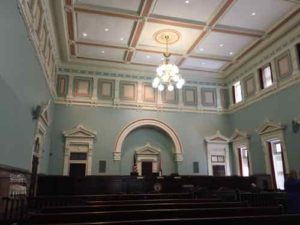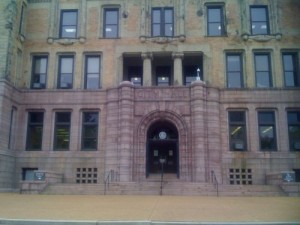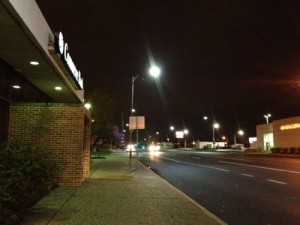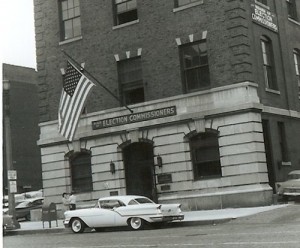Know Your Ballot: Judges

My post last week on the November general election ballot was on Propositions & Amendments. Today I’m looking at a part of the ballot people usually skip or just blindly say yes — judges up for retention. I’m no familiar with courts in other states, but it seems Missouri’s courts are different — in a good way:
Fed up with corrupt judicial elections, the people of Missouri adopted The Missouri Plan in 1940 and, two years later, reaffirmed their support in a statewide vote, rejecting the legislature’s attempt to repeal it.
The Missouri Plan is the foundation for merit-based judicial selection in America. Also known as the Non-Partisan Court Plan, it is Missouri’s constitutional system for selecting our appellate judges and trial judges in St. Louis, Kansas City, Clay County, Platte County, and most recently Greene County (Springfield). It is available to any county whose citizens wish to adopt it.
It works like this: citizens and lawyers, working as a team, serve on nominating commissions to select the best three candidates to fill an open judgeship. The governor then appoints one of those candidates to the position. Then, at the general election following their first 12 months on the bench and at the end of each term, each judge must stand before the voters in a retention election.
The process is both transparent to the public and accountable to the people.
The Missouri Plan has produced a steady stream of competent judges in Missouri for more than 75 years.
The plan continues to be right for the for the people of Missouri because it attracts high-quality judges in the least political way and ultimately gives the people the final say.
(YourMissouriJudges.org)
The reviews for all the judges up for renewal were published on September 29th, all were determined to substantially meet overall judicial performance standards. That said, we can review the evaluation results for each, as well as copies of opinions they’ve written.
The following questions are used in the evolution of each, with responses from strongly agree to strongly disagree:
- The judge treated the parties equally.
- The judge carefully considered arguments from both sides before ruling.
- The judge conducted the proceeding in a neutral manner.
- The judge maintained a professional demeanor in the courtroom.
- The judge was prepared for court.
- The judge’s ruling cited the applicable substantive law.
- Considering the amount of case law required to make the decision, the judge was prompt in rendering a decision.
- The judge gave reasons for a ruling when needed.
- The judge listened carefully during the court proceeding.
- The judge started courtroom proceedings on time.
- The judge allowed the appropriate amount of time for each case.
- The judge used courtroom time efficiently.
- The judge made sure all parties (attorneys and their clients) understood the court proceedings.
- The judge adhered to appropriate rules of procedure.
- The judge applied rules of evidence relevant to the case.
- The judge assisted parties in narrowing key issues in dispute.
- The judge’s decision followed logically from the evidence presented.
- The judge issued an order that was clearly written.
- The judge addressed individuals (e.g., attorneys, court staff, litigants, public, witnesses) respectifully in the courtroom.
The following are judges on city ballots, though the last three will be on ballots in other Missouri counties as well.
Associate Circuit Judges (3)
Judge Stovall-Reid was appointed associate circuit judge in 2003. She earned her J.D. from Washington University School of Law.
Prior to becoming an associate circuit judge, Judge Stovall-Reid was corporate counsel to the St. Louis Housing Authority (1997-’03). During her law career she has worked as a litigation associate for the law firm of Peoples and Hale (1995-’97) and served as an assistant circuit attorney (1993-’95) and an assistant public defender (1991-’93.) Judge Stovall-Reid has also served as a volunteer judge for truancy court for the St. Louis City Public Schools and teaches part-time at St. Louis Community College.
Judge Colbert-Botchway was appointed associate circuit judge July 2, 2015. She earned her B.A. and J.D. from St. Louis University and her MBA from the University of Missouri-St. Louis.
Judge Colbert-Botchway served as an administrative hearing commissioner for the State of Missouri when appointed to the associate circuit bench. After working in private practice and serving as an assistant circuit attorney for the St. Louis City Circuit Attorney’s Office, Judge Colbert-Botchway served as an assistant attorney general and unit leader for the State of Missouri for more than 10 years.
Judge Clark was appointed associate circuit judge Jan. 17, 2006, and retained in 2008 and 2012. He earned his B.A. from the University of Kansas and his M.A. and J.D. from Saint Louis University.
Judge Clark previously worked as an assistant circuit attorney in St. Louis from 1998 -2006.
Circuit Judges (10)
Judge Vannoy was appointed circuit judge Sept. 11, 2008, and retained in 2010. She earned her B.A. in political science and sociology from Douglas College-Rutgers University and her J.D. from the University of Missouri School of Law.
Judge Vannoy began her career as an assistant public defender for St. Louis County Circuit Court (1992-’95) and then as an assistant prosecuting attorney (1995-’96). She joined the legal department of the St. Louis County Family Court-Juvenile Division in 1996 and remained until December 2002, when she was appointed as a Family Court Commissioner for the 22nd Judicial Circuit in St. Louis City.
Judge Frawley was appointed circuit judge in September 1991 and retained in 1992, 1998, 2004 and 2010. Judge Frawley earned his B.A. from Hamilton College and his J.D. from the University of Missouri School of Law.
Judge Frawley previously worked in private law practice (1972 -’91.)
Judge Mason was appointed circuit judge in August 1991 and was retained in 1992, 1998, 2004 and 2010. He earned his B.S. from Austin Peay State University and his J.D. from Washington University.
Prior to his appointment, Judge Mason served as an assistant attorney general, general counsel to the Missouri Department of Corrections and was in private practice. Judge Mason has been a teacher of Trial Advocacy for The National Institute For Trial Advocacy, The Yeshiva University Benjamin Cardozo School of Law and several bar associations. He also has served as an adjunct professor of law at the Washington University School of Law since 1989.
Judge Mullen was appointed circuit judge in 2008 and retained in 2010. He received his B.A. and J.D. from the University of Missouri-Columbia.
Judge Mullen clerked for Judge James A. Pudlowski at the Missouri Court of Appeals Eastern District (1989 – ’90) before joining the St. Louis Circuit Attorney’s Office (1990 -’95). He worked for the Charles M. Shaw Law Firm (1995 -’96), was a partner in the firm of Mullen & Fernandez (1996 – 2000) and was a solo practitioner (2000 – ’01) before joining the bench as an associate circuit judge in 2001.
Judge McGraugh was appointed associate circuit judge Nov. 8, 2012, and appointed circuit judge April 15, 2015. He received his B.A. and J.D. from Saint Louis University.
Judge McGraugh previously worked as an assistant public defender in the St. Louis County Trial Division of the Missouri Public Defender’s office from 1987 to 1990. He was promoted to lead trial counsel for the Capital Litigation Division for the Eastern District of Missouri for the Missouri Public System from 1990 to 1992. From 1992 until his appointment, he was a principal in the law firm of Leritz, Plunkert & Bruning P.C., engaged in civil, criminal and appellate practice.
Judge Schaumann was appointed circuit judge Oct. 16, 1997, and retained in 1998, 2004 and 2010. He earned a B.A. from Missouri State University and a J.D. from Saint Louis University School of Law.
Judge Schaumann was a legal officer for the Circuit Court Juvenile Division (1973 -’75) and worked in private practice with the firm of Kuelker, Gates & Schaumann (1975 -’94.) He was appointed municipal judge for the City of St. Louis (1981 -’94) and served as the municipal court’s presiding judge. He was appointed associate circuit court judge in 1994.
Judge Heagney was appointed circuit judge Feb. 28, 1996, and retained in 1998, 2004 and 2010. Judge Heagney earned his B.A. from Johns Hopkins University and his J.D. from Harvard Law School.
Judge Heagney was previously a St. Louis City police officer (1970 -’73) and worked in private law practice for a small general practice firm in St. Louis (1976 -’96).
Judge Sullivan was appointed circuit judge Feb. 10, 2015. He received his B.A. from Southern Illinois University and his J.D. from Saint Louis University School of Law.
Sullivan has served as an assistant public defender, prosecuting attorney, and circuit attorney; St. Louis municipal court judge; and drug court commissioner for the 22nd Circuit Court. Prior to joining the bench, he was in private law practice for 20 years.
Judge Neill has been a circuit judge in the City of St. Louis since Feb. 15, 2002. He received his B.A. in history from St. Louis University and his J.D. from Saint Louis University School of Law. From 1973 until 1986, he was with the Legal Division of the St. Louis Metropolitan Police Department and served as law clerk, assistant legal advisor, legal advisor and general counsel. From 1986 until his appointment to the bench, Judge Neill was in the general practice of law. He handled a variety of trial and non-trial matters in Missouri and Illinois and in the federal courts.
Judge Hettenbach was appointed circuit judge April 2, 2008, and was retained in 2010. He earned his B.A. from the University of Missouri-Columbia, M.A. from the University of Michigan and J.D. from the University of Missouri School of Law.
Judge Hettenbach was in private practice for 23 years prior to being appointed to the circuit bench.
Missouri Court of Appeals, Eastern District (2)
Judge Dowd was appointed to the Missouri Court of Appeals in June 2015. Judge Dowd earned a B.A. in history from St. Louis University and a J.D. from the University of Missouri-Kansas City. Judge Dowd was previously with the James M. Dowd Law Firm, P.C.
Judge Hess was appointed to the Missouri Court of Appeals in December 2013. Judge Hess earned a B.A. in economics and philosophy from Rockhurst University and a J.D. from the University of Missouri.
Judge Hess was previously employed with Larsen & Hess P.C.; Randall, Keefe & Griffiths; Brown & Crouppen; Weier, Hockensmith & Sherby; and as a United States Senate page.
Missouri Spreme Court (1)
Judge Teitelman was appointed to the Supreme Court of Missouri in February 2002 and retained in office at the November 2004 general election for a 12-year term expiring December 31, 2016.
Judge Teitelman served a two-year term as chief justice from July 2011 through June 2013. He previously served on the Missouri Court of Appeals, Eastern District, from January 1998 to February 2002.
Voters in St. Louis County can review their judges here.
— Steve Patterson



